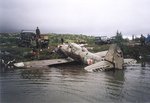This amazing Bell P39 was located at the bottom of Lake Mart-Yavr within the Russian Arctic Circle in the summer of 2004. As with other recoveries over the years, it was discovered by a fisherman who saw the silt covered outline through the crystal clear water.
The P39 sat on the bottom of a shallow lake at a depth of 5m, covered and buried up to the top of the propeller spinner in fine silt. Covered in silt, no markings were initially visible but after a little brushing, a red star appeared together with a yellow serial on the fin and rudder. With the serial now known, a search through the archives showed the pilot had disappeared on a transfer flight in November 1944.
Taking advantage of the good weather, the recovery team used air bags, tripod frames and a truck winch to bring the P39 to the shore. It caused concern that when the P39 emerged both the cockpit doors were still closed. Usually, if it was a water landing, one or both would have been jettisoned allowing for a quick exit. If the lake had been frozen, the team would still have expected one door to be open following any force landing.
The reason soon became apparent; for some unknown reason, the pilot had not exited the P39 and his remains were located in the cockpit. Missing for 60 years, the pilot was buried on 6 October 2004 with full military honours at the Glory Valley Memorial, near the Litza Valley, NW of Murmansk.
The P39 was remarkably complete, only missing the starboard inboard leading edge. As is always the case with magnesium-based components, the wheel hubs and engine cam covers to the engine had dissolved over the years and disappeared.
An interesting discovery was that the wing 0.5in machine guns had been removed. This in itself was not unusual, but in the area for the ammunition trays the team discovered six cans of American stew and spare lengths of ammunition. The 11 1/2 oz food cans contained cooked pork, lard, and onions with spices and had been packaged by Beerfoot Farms Company, Southboro. Massachusetts. USA. Not all lend-lease supplies were hardware!
The main fuselage weaponry was in place including the Colt-Browning M4 37mm cannon that fired through the spinner with 30 rounds of ammunition. The two 0.5inch heavy machine guns were located over the cannon and fired through the propeller and each had 200 rounds of ammunition as well.
The most amazing discovery was in the document case on the starboard door. The team located the maintenance record book for this P39. Although a few pages had perished, the majority was still legible. Nearly all of the Russian information that follows concerning flight hours/dates, servicing and pilots' names come from this unique document.
The P39 was easily disassembled before being transported to Moscow where it received its export licence. It was then transported to Jim Pearce's facility in West Sussex where it is currently being cleaned up and inspected. This amazing and historic P39 is currently for sale.
(part 1 )
The P39 sat on the bottom of a shallow lake at a depth of 5m, covered and buried up to the top of the propeller spinner in fine silt. Covered in silt, no markings were initially visible but after a little brushing, a red star appeared together with a yellow serial on the fin and rudder. With the serial now known, a search through the archives showed the pilot had disappeared on a transfer flight in November 1944.
Taking advantage of the good weather, the recovery team used air bags, tripod frames and a truck winch to bring the P39 to the shore. It caused concern that when the P39 emerged both the cockpit doors were still closed. Usually, if it was a water landing, one or both would have been jettisoned allowing for a quick exit. If the lake had been frozen, the team would still have expected one door to be open following any force landing.
The reason soon became apparent; for some unknown reason, the pilot had not exited the P39 and his remains were located in the cockpit. Missing for 60 years, the pilot was buried on 6 October 2004 with full military honours at the Glory Valley Memorial, near the Litza Valley, NW of Murmansk.
The P39 was remarkably complete, only missing the starboard inboard leading edge. As is always the case with magnesium-based components, the wheel hubs and engine cam covers to the engine had dissolved over the years and disappeared.
An interesting discovery was that the wing 0.5in machine guns had been removed. This in itself was not unusual, but in the area for the ammunition trays the team discovered six cans of American stew and spare lengths of ammunition. The 11 1/2 oz food cans contained cooked pork, lard, and onions with spices and had been packaged by Beerfoot Farms Company, Southboro. Massachusetts. USA. Not all lend-lease supplies were hardware!
The main fuselage weaponry was in place including the Colt-Browning M4 37mm cannon that fired through the spinner with 30 rounds of ammunition. The two 0.5inch heavy machine guns were located over the cannon and fired through the propeller and each had 200 rounds of ammunition as well.
The most amazing discovery was in the document case on the starboard door. The team located the maintenance record book for this P39. Although a few pages had perished, the majority was still legible. Nearly all of the Russian information that follows concerning flight hours/dates, servicing and pilots' names come from this unique document.
The P39 was easily disassembled before being transported to Moscow where it received its export licence. It was then transported to Jim Pearce's facility in West Sussex where it is currently being cleaned up and inspected. This amazing and historic P39 is currently for sale.
(part 1 )










